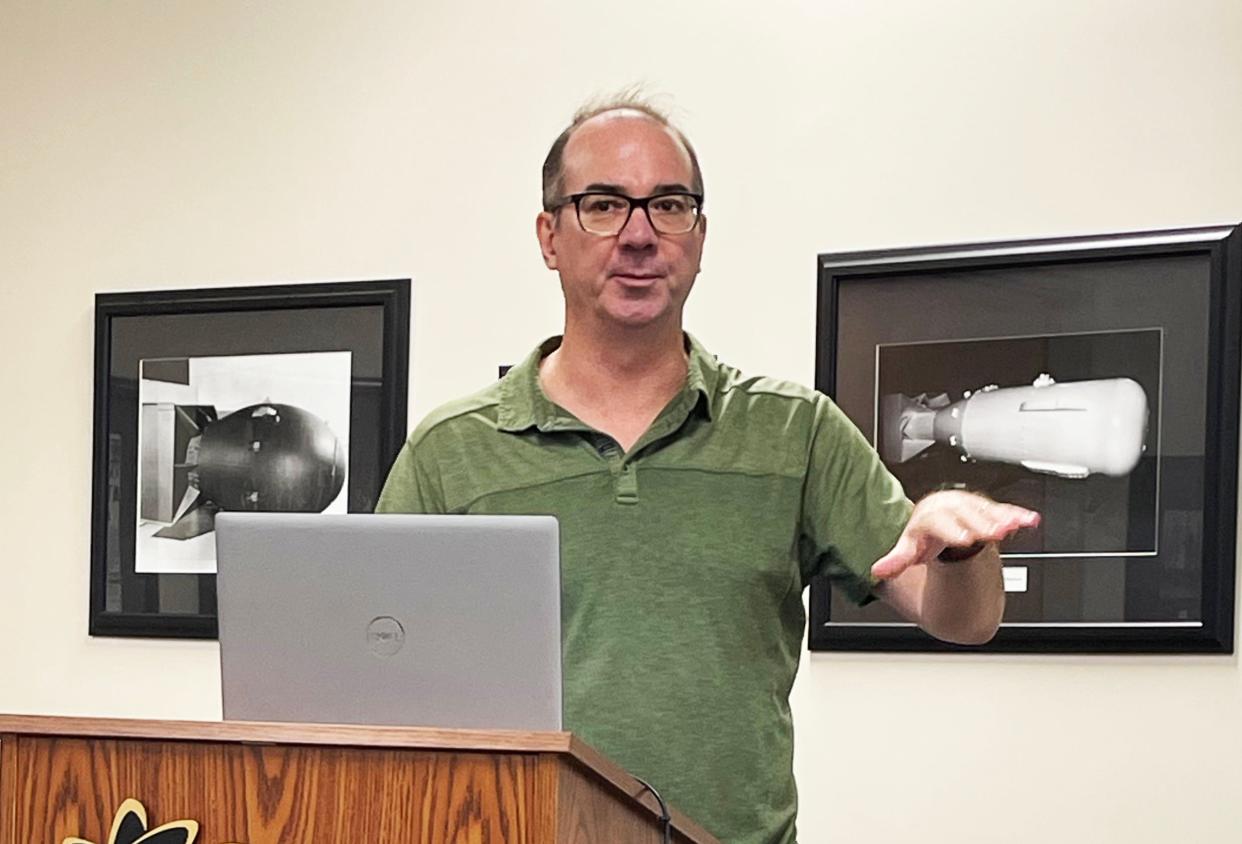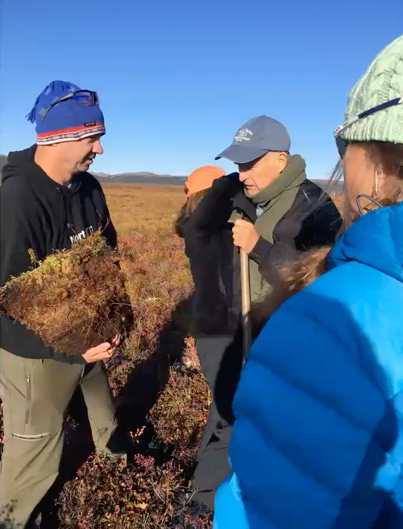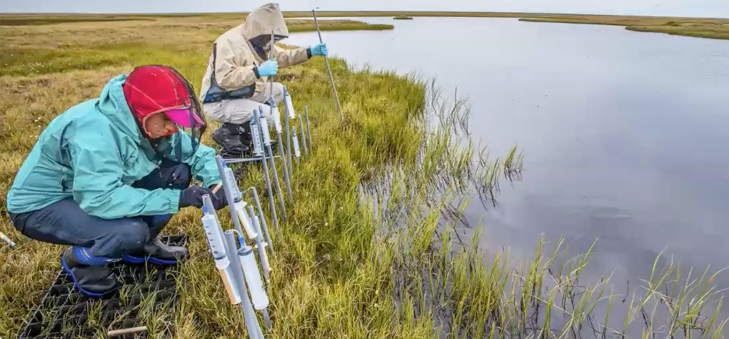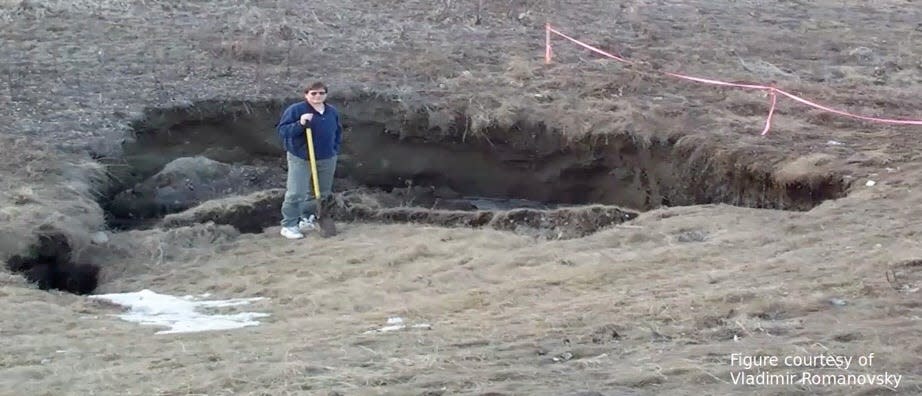Arctic soil thawing poses risks to Alaskan life and climate
The frozen soil in Alaska known as permafrost is gradually thawing in many areas because the Arctic region is “warming at a pace three to four times faster than the rest of Earth,” said Bob Bolton, deputy of operations for the Next-Generation Ecosystem Experiments in the Arctic (NGEE Arctic) project, led by Oak Ridge National Laboratory.
The reason for the thawing is climate change.

In his recent talk to Friends of ORNL titled, “Uneven Ground: What Happens When Permafrost Thaws?,” Bolton said that ground collapse, erosion and floods in Alaska have damaged houses and roads and caused losses of, or problems accessing, salmon, berries, animals hunted for food and other resources Native Alaskans depend upon.
Plant matter trapped in the frozen ground stores carbon but does not decay until permafrost thaws, he explained. As the soil warms, microorganisms within the dead plant material break it down, releasing carbon dioxide and methane into the atmosphere.
“In the permafrost regions in the northern hemisphere, about two and a half times as much carbon is stored in the ground than is actually in the atmosphere right now,” Bolton said. He added that releases of these greenhouse gases from thawing permafrost could accelerate warming, triggering even more permafrost thaw and carbon emissions in a self-reinforcing loop.
However, when asked about a postulated tipping point in a decade in which the warming planet’s atmosphere might have a greenhouse gas concentration up to two-and-a-half times what is there now, Bolton replied, “Carbon dioxide and methane are not all going to be released from thawing permafrost at once. It’s going to take some time. I don’t believe we will experience the carbon bomb that some people talk about.”

Bolton grew up in Wyoming and Idaho but spent more than 35 years living and working in Alaska, which has 22 hours of daylight in the summertime and four hours of daylight in the wintertime. In July 2023, he and his wife Rachael drove 5,130 miles to relocate to Oak Ridge for his new NGEE Arctic position (although he will continue to do some work with his colleagues in Alaska). He studied permafrost while working on his Ph.D. in hydrologic engineering at the University of Alaska Fairbanks, where he later became a research professor.
“Permafrost is any ground that remains frozen for two or more consecutive years,” he said. “It can be any combination of soils, rocks or ice. It formed 100,000 to 10,000 years ago during the last ice age, and it composes about 24% of the land area in the northern hemisphere. So, it takes up a huge amount of land.”
In Alaska, he is known as a “permafrost expert.” He was recently asked by an Alaskan real estate agent if a house damaged because the ground was sinking below half of it as a result of permafrost thaw was an “act of God.”
Bolton showed a photo of a home outside of Fairbanks that had fallen over into the ground.
“This house was built directly on top of what became warm permafrost,” he said. “Any heat from the basement caused the soils to thaw. Eventually, the house just tipped over.”
The house had been constructed before builders knew about the need for “permafrost engineering,” he said, adding that, “All the houses I lived in were built on stilts that went down to bedrock. The stilts allowed cold air to circulate underneath the house, keeping the ground frozen.”
The uneven ground resulting from permafrost thaw and movement of water over land has damaged many roads in Alaska, Bolton said.
“Road problems became common where I lived in Fairbanks,” he noted. “The snow melts and the water transports heat into the ground where warm permafrost is already present. The ground collapses, forming sinkholes next to or in a road. Many of the roads need to be repaired every year.”
He told the FORNL audience about the haul road between Fairbanks and the north slope of Alaska over which food, other supplies and logistical support needed by the oil industry are transported. It was closed for about three weeks until a new road could be built. The reason: a huge flood eroded away the underground ice wedges, causing the ground to give way.

Bolton said research shows that underground ice wedges formed hundreds to thousands of years ago puts soil under tension and causes the ground to crack, allowing water from melting snow to seep into the cracks, refreeze into ice that expands and causes more cracking, and ultimately, forms very large wedges of ice. He said the melting of these ice wedges contributes to the ground collapse.
In Bethel, a small community southwest of Fairbanks, the permafrost is dying, he added. He explained that because Bethel obtained funding to pave its dirt roads, the change in the energy balance caused by the dark asphalt’s absorption of the sun’s heat triggered uneven thawing of the ground and damaged the town’s roads.
Many Alaskans rely on foods obtained from local plants, fish, and mammals. Bolton said thawing permafrost “has an impact on berries and berry distribution.” Many Alaskans rely on seasonal berries, including blueberries, cranberries, and raspberries, “for their food supply,” he said.
Because forest trees growing on thawing permafrost are falling into rivers, “in many rural communities, the residents are no longer able to access their traditional hunting grounds and fishing areas,” Bolton said. That means it is difficult to navigate upstream to hunt for animals needed for meat (such as moose, caribou and bears) or fish for salmon, an important food source.
“They talk about ‘chain-sawing their way up the river,’ but that’s not feasible in terms of time, energy and cost,” Bolton noted.
He said thawing permafrost has adversely affected salmon availability and Alaskan fisheries in general. The warmer groundwater has raised river temperatures and the erosion of soil that’s no longer frozen has elevated levels of suspended sediments in some rivers, potentially impacting spawning habitat.
Bolton said Red Dog Operations, which operates one of the world’s largest zinc mines near Kotzebue in northwest Alaska, had to spend $20 million to build a big impoundment pond to retain water to stop the flow of sediment into a stream in amounts above the legal limits.
He noted that permafrost is sensitive enough to thaw and then give way just from repeated walking over a path by reindeer (or a Ph.D. student like him doing a field study). Showing a photo, he said, “I caused thermal erosion of the soil by walking across the ground time after time over several years. I made enough of a path to make the warm permafrost fall in and create a gulley.” He added that boardwalks are now present in permafrost areas studied by researchers.
The overall goal of the NGEE Arctic Project, Bolton said, is to advance scientists’ understanding of the rapidly changing terrestrial Arctic through ground observations and improving the predictive power of the Department of Energy’s Earth system model. These climate models are run on supercomputers at ORNL and elsewhere. The project, which started in 2012, will end in 2027. It is supported by the Office of Biological and Environmental Research in DOE’s Office of Science.
As a hydrologic engineer, he has worked on one of the six science questions addressed by the project: Where, when and why will the Arctic become wetter or drier? In his words, he asks, “how much water is on the landscape, how does it move through the landscape and how is it distributed?”
He talked about some of the research he had conducted on Alaska’s Seward Peninsula in collaboration with ecologist Jessie Young-Robertson, with whom he also launched the “Alaska Voices” podcast in which community members, policy makers and researchers share stories about living in a changing state. In one podcast, Victor Tonuchuk Jr., said that in the past 15 years, “We’ve seen a lot of changes in our climate with floods, erosions, fall storms.”
“The permafrost is degrading, but it doesn’t degrade everywhere or all the time,” Bolton said, prompting him to identify triggers of “the start of the degradation process.” In 2017, he said, “we measured an unusually shallow snowpack and in 2018 a deep snowpack that came early in winter. Its depth was what we were used to. In the summer prior to the 2017 winter and the summer after that, we experienced warmer temperatures than usual. And the winter in between 2017 and 2018 was warm enough that the ground didn’t refreeze all the way because the only heavy snow we had came early.
“I think what happened is that because Alaska had a warm summer, the ground was thawed. The early and deep snowpack served as a good insulator, trapping the heat from the summer in the ground and further thawing the permafrost. The stars basically lined up, flipping the switch from freezing to thawing.”
Bolton called the phenomenon “climate priming” because “the climate primed the frozen soils for degradation,” or thawing that could lead to carbon emissions by microbially degraded organic matter. He noted that the opposite effect could occur when an Alaskan region has “two cool summers and no snow in the winter between so all the heat escapes into the atmosphere. In that case, the permafrost that might have been susceptible to thawing before may harden.”
Bolton and colleagues created a “climate priming index” that combined summer temperatures, rainfall and early and total snowfall in one-by-one square kilometers for the state of Alaska. Using this analysis, Bolton indicated that large parts of Alaska are now more susceptible to thawing permafrost than in the early decades of the 1900s.
There are different types of permafrost, Bolton told the FORNL audience. The “continuous permafrost” dominating the far northern Arctic latitudes, which can be many hundreds of meters deep, is very cold and stable.
Moving southward into interior Alaska, we find ‘discontinuous permafrost,’ which covers 50% to 90%of the landscape and can be less than one meter thick to more than tens of meters,” he said. On south-facing slopes, where the sun angle is low and solar radiation strikes the landscape directly, terrain can be permafrost-free, he said, adding later that this permafrost with a temperature close to 0°C (32°F) is at the tipping point.
Further south, he added, the terrain is less than 50% permafrost, which is present in sporadic and isolated patches. He noted that climate-related increases in wildfires could hasten permafrost thawing in places.
Bolton compared discontinuous permafrost to a solidly frozen half gallon of ice cream that is allowed to warm up at room temperature.
“At first it’s hard to dig into it when you try to scoop it out because it’s really stable,” he said. “When it’s ready to start thawing, getting that scoop of ice cream out doesn’t take a lot of energy.”
Fortunately, he delivered some sweet news when he revealed that the continuous permafrost in the region close to the North Pole is still very stable.

This article originally appeared on Oakridger: Arctic soil thawing poses risks to Alaskan life and climate
